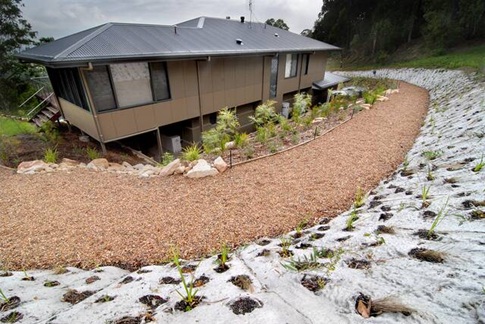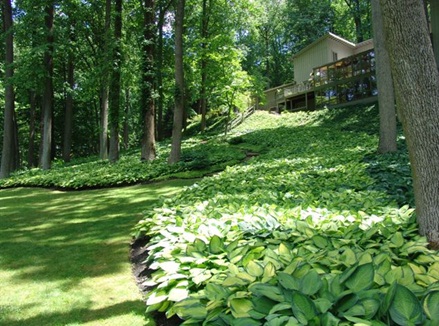Categories
Calendars
Guides
Reviews
Archive
Gallery
Articles
Ask Our Gardening Expert
>Ground Cover
Ground cover will reduce evaporation from free-draining soils and the leaf mould produced will act as mulch.
Erosion control with a new ground cover planting
As well serving a practical function, ground cover plantings can be decorative in their own right providing areas of colour, texture and uniting the areas between large plants and trees. In many ways we are emulating natural growing situations in woodlands where ground plants inhibit the growth of others by depriving them of light, water and nutrients. In the garden, an effective ground cover planting needs very little maintenance.
Select attractive, vigorous plants that quickly cover their space with a dense growth without becoming invasive. They should be perennial, growing above ground all year to produce a green ‘carpet’, or rapidly regrow in spring. Avoid frost tender plants. Choose plants that will thrive in the given situation, be it wet, dry or shady. They should only need occasional feeding and clipping.
Prepare the soil as for other plantings. Before planting, remove perennial weeds by hand or chemical means. Work in large quantities of compost or well rotted manure. Plant out with recommended spacing for the plant species and cover the bare soil with mulch. An idea would be to mark out a grid with spaced strings and plant where they intersect. Fast growing plants may take two or three years to fill the gaps.
Hosta used as ground cover has plenty of variation in foliage and flowers, used here to link established trees.
Many ground cover plants can be propagated by cuttings or division and planted directly into the soil. A suitable subject like the ivies or agapanthus can be broken up into many pieces and planted to cover a considerable area. Ground cover should need little care, though hypericum, after a few years, would benefit from cutting back to stimulate fresh growth.
Growing a dense mat of foliage or flowering plants is a useful way of suppressing weeds, replacing a lawn or preventing soil erosion by stabilising bare slopes.
